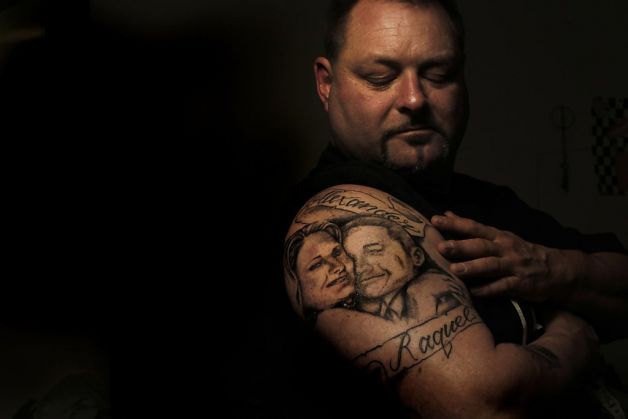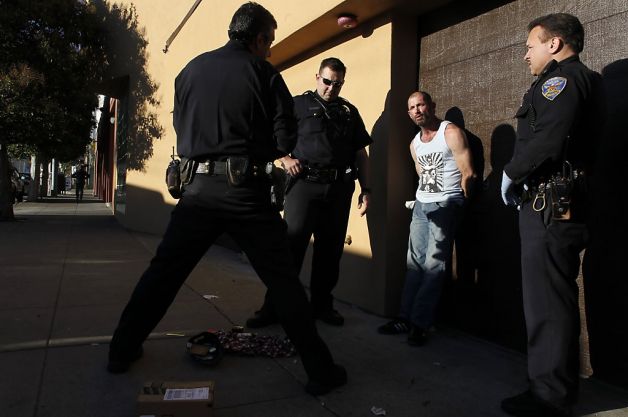| |
Read more: http://www.sfgate.com/crime/article/Bay-Area-homicide-rate-rises-in-2012-4189892.php#ixzz2I0Josi9d
Updated 11:28 pm, Saturday, January 12, 2013 Bay Area homicide rate rises in 2012
Demian Bulwa and Justin Berton

Barton Gerstel shows the tattoo he had done of his deceased daughter, Raquel, and his son, Alex. Raquel and a friend were shot dead in Oakland in November. Photo: Michael Macor, The Chronicle
It's no surprise to LaTanya Lozano that homicides are up in the Bay Area's biggest cities. She moved to Hayward in late 2011 to try to protect her four sons, only to see two of them shot dead last year back where she used to live, Oakland.
First her 15-year-old, Shonte Daniels Jr., was shot by a 14-year-old friend in a park, apparently after teasing him. Six months later, in October, 21-year-old Rashad Meredith was caught in the middle of a gunfight between rival groups outside his aunt's apartment.
"This tore down my whole life," said Lozano, who was hospitalized in November after attempting suicide with pills. "When I was growing up in Oakland, we fought. But kids these days play with guns."
Lozano is among the wreckage left behind by a rising Bay Area homicide rate, a trend that is chipping away at cities' hard-fought overall reductions in crime.
The jump in killings is prompting some police leaders to blame a shrinking of their forces, which they say has hampered their ability to do proactive work targeting gang members and others who sell drugs and often settle disputes with guns.
Boost in biggest cities
The region's 15 biggest cities saw 310 homicides last year, according to interviews with city officials. That was up from the 275 homicides in 2011 and 248 in 2010 that the cities reported to the state Department of Justice and the FBI.
The increase, however, was driven almost entirely by the region's three largest cities, San Jose, San Francisco and Oakland, where killings rose 52 percent in two years.
Taken together, the other dozen cities had 24 percent fewer homicides over the same period.
The Bay Area's homicide rate fluctuates for reasons that are difficult to measure, and it remains well below historic highs.
But the uptick is fueling concern, including over cuts in law enforcement. Owing to attrition and budget battles, San Jose has lost about 350 officers in the past few years, San Francisco about 300 and Oakland more than 200. Each city is now trying to hire and train replacements.
Specialized units cut
San Jose remains relatively safe, with a per-capita murder rate that is less than one-sixth Oakland's. But Sgt. Jason Dwyer, a police spokesman, said the cuts in the force appeared to be linked to the city's count of 46 homicides last year, the most since 1991.
"I don't see how we can ignore that fact," he said.
Through September, major violent and property crimes in San Jose were up 23 percent.
San Jose police had to eliminate units that dealt with quality-of-life crimes like graffiti, prostitution and burglary, Dwyer said, while gang units were cut or absorbed into larger divisions.
In Oakland, where major crimes rose 23 percent last year and 126 people were slain, specialized police units have also dissolved. Records show officers are stopping and arresting fewer people and solving fewer killings.
The picture in San Francisco is more mixed, with overall crime holding steady. The city's homicide total of 68 was 18 more than in 2011 but fewer than in any of the years from 2004 to 2008, when the lowest annual murder count was 86.
The rise in homicides "is concerning and is something I believe we should all be looking at," said San Francisco District Attorney George Gascón. "We need to make sure we don't go back to where we were before. That requires really thoughtful attention to details."
Grim times in Stockton
The trend is perhaps bleakest just outside the Bay Area, in Stockton, where homicides soared from 24 in 2008 to an all-time high of 71 last year. The city's per-capita homicide rate eclipsed that of Chicago, where a violent 2012 made national news.
Stockton's violence worsened along with deep financial problems that brought a bankruptcy filing in June and a downsizing of the police force, from 441 officers in 2008 to a current count of 327.
Department spokesman Officer Joe Silva said about half the city's homicides in 2012 were related to gang warfare.

(l to r) Sgt. Troy Carrasco, Officer Mark Hodge and Officer Jordan Oryall, with the San Francisco Police Department out of Southern Station, make an arrest of a burglary suspect on 5th St. near Folsom St. in San Francisco, Calif. on Wednesday Jan. 2, 2013. Photo: Michael Macor, The Chronicle
"Once we had to eliminate our proactive units - including a gang unit - we saw these gang members getting brazen," Silva said.
One of last year's homicide victims in Stockton was a 56-year-old woman caught in a gang shootout while walking to a store. "It was 1:12 in the afternoon. Broad daylight," Silva said. "That tells us they're not much worried about police driving by."
Richmond turnaround
There's a different story in Richmond, which used to be known as one of the nation's murder capitals. In 1991, 62 people were killed there. In 2012 the total was 18, the lowest in 11 years.
Unlike in other big cities in the Bay Area, Richmond has been adding police officers - 40 since 2006, to bring the force to a total of 190. The city also increased its use of crime-mapping and other technologies, strengthened community outreach programs, and opted to pay for two Contra Costa County prosecutors to work at the Police Department on gang and gun cases.
"I don't think there's any question that it helps to be fully staffed," said Police Chief Chris Magnus. "But the way in which officers are deployed is really important, too, as are the kinds of relationships police build with the community."
Last year's Bay Area killings included the slayings of five people who were bludgeoned and slashed in a San Francisco row house in March, and a gun rampage at an Oakland college the next month that left seven dead.
But most homicides followed familiar themes, officials said: Many of the victims were young men of color killed in rough neighborhoods by people they knew, and the disputes were typically over gangs, drugs or more trivial matters.
'Baby gangster'
Lozano, the Hayward mother, said her 15-year-old son had called his friend a "BG" - a "baby gangster" - before being shot.
Her son had been in and out of juvenile lockups - often for stealing cars, she said - and was wanted by police when he was killed by his friend. He had refused to move to Hayward, Lozano said, instead staying with friends in Oakland.
"Shonte lived the life of a grown man," his mother said. "I knew it might catch up with him, but I didn't think it would be at the hands of friend."
Kevin Grant, an ex-convict living in Oakland who consults with cities on how to defuse violent situations, said that "the biggest dynamic in these homicides is spontaneity. Any drama, any issue with these young ones often leads to violence."
Going after guns
Grant added, "If there was one thing I could point to, I would start with getting the guns. That's the only place we're going to beat this."
In San Francisco, 45 of the 68 victims were slain by a gun, said Deputy Chief Jim Dudley. The prime motive to kill was a dispute or a robbery. Sixty victims were men, he said, and 35 were black, even though African Americans make up just 6 percent of the city's population.
Those who study crime trends in the Bay Area say it is too early to tell what is pushing up homicides in the biggest cities, or whether the jump is tied to cuts in police staffing.
"The thing that caused the decline in police resources - namely, the lousy economy - can also explain a lot of other factors that can influence crime," including unemployment, said Robert Weisberg, a law professor who co-directs the Stanford Criminal Justice Center.
"The most worrisome possibility," he said, "is that there's a limit to how much you can reduce crime in America. This is a bit of a regression to the mean, though not much of a regression. Things are still a hell of a lot better than they were 30 years ago."
Franklin Zimring, a UC Berkeley law professor and criminologist, noted that San Francisco and San Jose still have relatively low per-capita homicide rates.
"There's nothing in the aggregate homicide totals that citizens in those cities should find scary," he said. "If you're the mayor of San Francisco or San Jose, the best adjective would be 'concerned,' but not 'worried.' If you're the mayor of Oakland or Stockton, it's 'worried.' "
Richmond encouraging
Zimring added, "The biggest story is Richmond. After bouncing around a lot, it's not merely down for 2012 but way down - and it's not a one-year number but a three-year downward trajectory, which is extremely encouraging."
He was cautious about connecting police staffing levels to homicide totals, noting that the two numbers haven't always tracked each other in the Bay Area.
For some police officials and tough-on-crime advocacy groups, the rise in homicides is raising questions about realignment, Gov. Jerry Brown's plan to reduce overcrowding in state prisons. Under the program, which began in late 2011, those convicted of nonviolent felonies serve time in county jail - or under supervision in the community - instead of in a state lockup.
"When you lower the consequences for these offenses, these guys move up the food chain and become more sophisticated criminals," said Michael Rushford, who heads the Criminal Justice Legal Foundation, a victims' rights group in Sacramento that is working to pull back some aspects of realignment.
Major L.A. crime down
But no studies have been done yet to measure exactly how many convicts are on the street rather than behind bars as a result of realignment, and whether they are committing crimes.
Zimring said that if realignment were pushing crime, he would expect to see increases that were more uniform across the Bay Area and the state. But California's biggest city, Los Angeles, reported a slight decrease in major crimes last year.
"We have to be very careful we don't attribute (crime increases) to realignment," said Gascón, a supporter of the policy. "Then what we're saying is that it's beyond our control."
Demian Bulwa and Justin Berton are San Francisco Chronicle staff writers. E-mail: dbulwa@sfchronicle.com, jberton@sfchronicle.com Twitter: @demianbulwa, @justinberton
Read more: http://www.sfgate.com/crime/article/Bay-Area-homicide-rate-rises-in-2012-4189892.php#ixzz2I0JQYVE0
|
|

